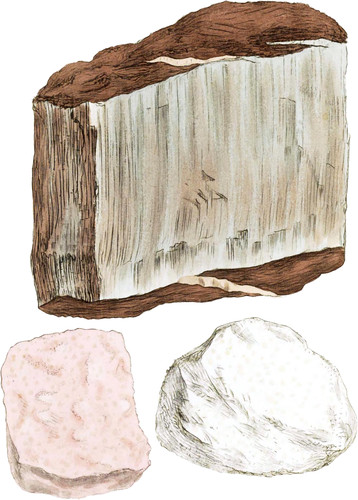 Enlarge
Enlarge
British Mineralogy
Fibrous Gypsum
- Class 2. Earths.
- Order 1. Homogeneous.
- Gen. 3. Lime.
- Spec. 3. Sulphate of Lime.
When on the coast at Sidmonth, I had the gratification of seeing the red marly sides of ihe cliffs or rocks beautifully, to appearance, veined with red and white Gypsum, from half an inch or less to a foot or more in thickness, for many feet below the summit; and from what I have been informed by my friend Mr. Murray, it should seem that it has much the same appearance at the beautiful grove near Clifton Hall in Nottinghamshire, the seat of Sir Jervas Clifton. The Marle varying between these veins, which are often very broad, is commonly called Red-rotten-stone-rock*, and is sometimes intermixed with a greenish, more or less indurated, Marle. The Red-rotten-stone-rock moulders on exposure to the air, and often leaves the Gypsum projecting in flattish shelves, which also sometimes moulder or fall down, sooner or later, according to their purity or some other circumstances.
The upper specimen, figured in this plate,is from Clifton†, with the Marie above and below it. It is often very red, as if stained with the Marle: the present is a greyish specimen, with the appearance of the Sulphate of Strontian found in a rock of the same nature in the neighbourhood of Bristol, where Gypsum is indeed sometimes found, but may be easily distinguished from that heavy earth, by its being so much softer and lighter. I chose this specimen for the sake of comparison. This finely fibrous variety, and the coarsely striated one, may make several degrees to the more compact or amorphous sort one way, or to the crumbly or dusty the other way.—This latter is said to be washed from the Gypsum in the rocks, and is called Gypsum earth, but is a mere variety, and seldom occurs: indeed it would seem rather remarkable if it should remain long in a dusty state, especially as at the Baths of St. Philip, in Tuscany, the stream deposits the Gypsum as it passes, so as to make casts. This is now so contrived as to deposit it with the greatest nicety into moulds of the neatest workmanship, when generally the basso-relievo medals or figures taken out, are as hard as those made from baked or manufactured Plaistcr of Paris, as it is usually called.
Gypsum has been in use for ages as a manure, and is now become very fashionable, large manufactories being established for grinding, and patents taken out for the preparation.
- * The substance has nothing in common with the Rotten Stone used by the lapidaries, tab. 240.
- † I have specimens from Forth River, near Belfast, by favour of Mr. Drummond.

